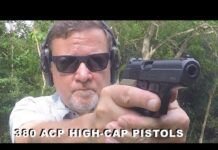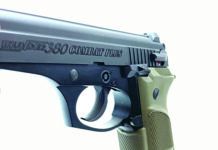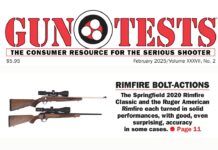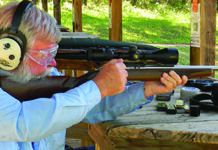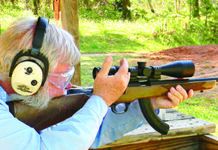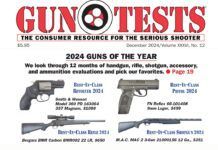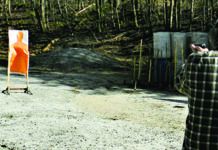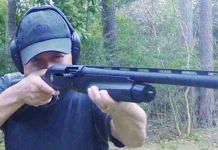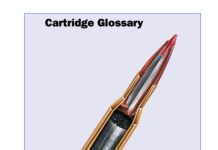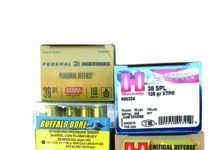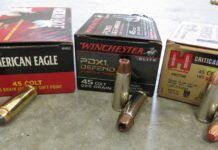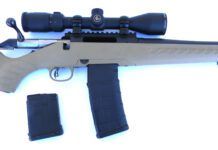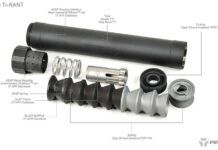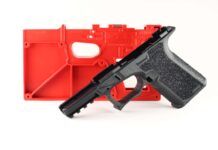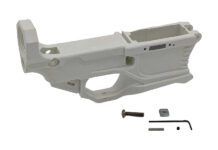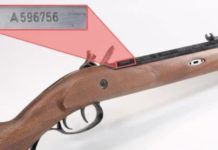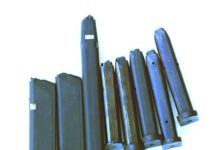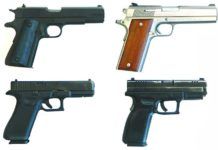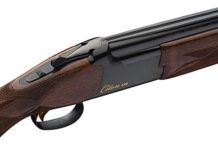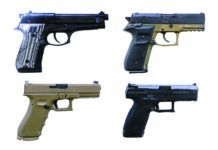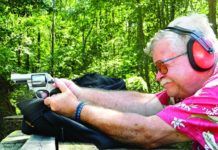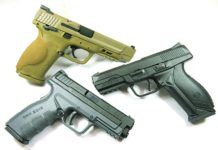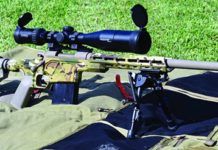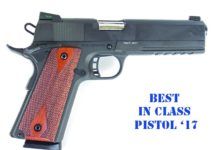Lyman Recalls Black-Powder Rifles and Pistols
Gun Tests has learned that Lyman Products Corp. ("Lyman") is voluntarily recalling black powder rifles and pistols due to the potential of separation in the breech plug.
Non-1911 Magazines: We Test A Passel of Them Head to Head
You can never have enough magazines. Modern pistol shooters practice hard; compete in IDPA, IPSC, and Three Gun matches. They need reliable equipment. Personal-defense shooters need reliable, functional magazines at a fair price. In this installment, we are testing magazines for fit, function, reliability and durability. In common with recoil, striker, and hammer springs, magazines should be replaced from time to time. While new springs may help magazines retain some function, there is a time when cracked or bent feed lips demand the magazine be discarded.
In this test, we followed the same criteria we used in testing 1911 magazines, except this test was more diverse in both handguns and cartridges. The handguns used in the test were proven examples, with few function exceptions. Since the firearms had long-ago proven reliable, there would be no confusion as to which part was responsible for the malfunction, the pistol or the magazine. We also used good-quality ammunition to test the magazines. In each case, we used at least two magazines of each type to bang on.
Using proven criteria and a team of experienced raters, we learned some magazines were durable and service grade; that is, we would be comfortable putting them into "service" in critical situations. We also learned others were okay for range use, but not critical use. In all of these cases, we recommend spending a little more for service-grade magazines across the board for all uses. We don't think it's advisable to mix low performers with high performers in this critical area of function.
Hot Handguns and Cartridges From Springfield, Coonan, Glock
For more than a year, we have been testing and evaluating some of the most powerful and interesting self-loading handgun cartridges. These are the ubiquitous 9mm Luger, which we think has become the baseline against which all other handgun chamberings can be compared, and the far-less-common but still commercially viable 38 Super, 357 SIG, and 357 Magnum, the last of which is chambered in a Coonan handgun. The evaluation was the result of a reader request, and three of which, the 9mm, 38 Super, and 357 SIG, sometimes use the same bullets, but at different velocities.
We began with a number of goals. First, as always, reliability has to be foremost because the handguns were competing as personal-defense choices. We also viewed them as outdoors-carry choices for defense against feral dogs and big cats. We wanted to see how efficiently each cartridge delivered its power, with the idea that the 9mm set the floor. Increased flash, blast, and recoil may be counterproductive in the others, and as it turned out, we got more horsepower with less recoil than expected. The energy difference wasn't incremental; it was profound. We didn't choose average 9mm or 38 Super loads, but instead picked those loads that had given good results in the past. Only the top performers in 9mm and 38 Super are in this report. With the 357 SIG and 357 Magnum, we were on new ground and chose a representative sample of bullet weights. The 357 SIG and 357 Magnum enjoy an excellent reputation for terminal ballistics. The 9mm, less so, and based on previous data, we expected the 38 Super to be as effective or more than a 9mm Luger +P+ load. The primary consideration was personal defense, so control was important. The larger guns may not be ideal for concealed carry, but would be good handguns for field use or home defense. For those wishing to deploy a handgun with plenty of power and accuracy, the 357-caliber self-loaders are easier to control than Magnum revolvers. The self-loaders demonstrate less recoil due to the smaller charge of faster-burning powder and the movement of the action and compression of springs as the handgun is fired. So how would they compare to the revolver? As it turned out, these modern powerhouses outclass the 357 Magnum revolver, in our opinion, on many levels.
We collected a good supply of ammunition, five loads for each gun versus our usual three. We chose three powerful hollowpoint loads for accuracy testing, as is SOP for Gun Tests. We added a fourth load for ballistic testing to test penetration and expansion. We added an economical practice load for use in the combat-firing test phase. So, this was a thorough test requiring several months. We elected not to go lighter than 115-grain bullets in any chambering. The 357 SIG, 38 Super, and 9mm Luger are usually loaded with bullets in the range of 115 to 147 grains. We fired 125-, 140-, and 158-grain bullets in the 357 Magnum Coonan. Here are the results.
Kimber Aegis Pistol Introduction: SHOT Show 2018
Gun Tests Editor Todd Woodard interviews Kimber Creative Lead Rachel Maloney about the company's new Kimber Aegis optics-ready pistol.
SHOT Show 2018: New Shotguns
Gun Tests reporters and editors on the scene at SHOT Show 2018 in Las Vegas have been scouring the show for new rifle, pistol, shotgun, and accessory entries for our readers to consider this year. Here's a rundown on quite a few just-introduced scattergun choices for 2018, some of which we'll be looking at for further examination later this year.
Senator Wants Out-of-State CCW Holders in Jersey to Go to Jail
New Jersey has some of the most stringent CCW gun laws in the country. Its state troopers are known to pull over drivers and question them on whether they are carrying concealed firearms.
Service-Sized 9mm Handguns Shoot It Out for Carry Honors
We recently tested a quartet of 9mm-chambered full-size firearms suitable for daily carry: the Lipsey's Glock 17RTF2 Vickers FDE based on the Glock 17, a Beretta 92FS with Wilson Combat upgrades, an Arex Rex Zero 1 Standard, and a CZ-USA CZ P-10 C. Each one could be thrown into any mix of handguns and do well. But there are specific differences that will make one pistol or another preferable for an individual, and that is what this shoot out is all about.
Full-size 9mm handguns have an impressive reserve of ammunition, they handle recoil well, and offer real power with +P loads. For home defense, a 14- to 18-shot 9mm handgun is effective, perhaps the best all-round home-defense handgun for a trained shooter. In this test, each pistol is an example of a popular carry gun as well, with many shooters concealing a Glock 17 or even a Beretta 92FS for daily carry. Here, all had faultless reliability, which is a prerequisite for a defense firearm in our testing. We also learned the Lipsey's/Vickers Glock gave excellent results on the combat course, and the Wilson Combat-upgraded Beretta aced the field in accuracy. We trust these pistols, but only one was the best performer overall for our shooters. For certain preferences and duties, each has advantages, which we note in detail below.
All handguns tested for personal defense must be proven on the firing range. We tested two examples of upgraded service pistols. A special-run RTF texture Glock 17 from distributor Lipsey's has a Vickers Tactical package added to it, with components suggested by or supplied by well-known trainer Larry Vickers. Likewise, we tested a Beretta 92FS updated with Wilson Combat parts. The results for both are better range performance, especially when performing rapid magazine changes because each package features a magazine guide and magazine base pads.
We matched the Glock and Beretta against the new CZ P-10 C, a polymer-frame striker-fired pistol, and the Arex Rex Zero 1 Standard, which is considered by some to be an improvement over the SIG P226 9mm handgun. We had a mix of two double-action-only polymer-frame striker-fired pistols, a double-action-first-shot pistol with a decocker, and a selective-double-action pistol with decocker.
In the end, the Glock's highly advanced sights provided excellent results on the combat course. Perhaps the RTF frame was another plus. The Beretta 92 provided exceptional accuracy, which we felt was due to the improved trigger action. The CZ is an affordable and reliable handgun, and the Rex Zero is a good example of European craftsmanship. All in, it was hard to isolate a winner among these top-flight handguns with good performance. We think that most shooters will find the Glock 17 to be the best overall handgun for personal defense and home defense. Just the same, the CZ P-10 C is a good buy. Those seeking top-flight accuracy will find the Beretta to be a good fit. The Rex Zero has a quirk we did not like regarding reach to the magazine release, but the Arex is a good performer for some shooters, outperforming the Beretta in combat shooting. As usual, the devil is in the details, so here we go.
Five-Shot 44-Caliber Revolvers From Ruger, S&W, and Taurus
The medium-frame 44-caliber revolver, whether chambered in 44 Special or 44 Magnum, is a great outdoors revolver, often used for defense against animals. We agree that this is a formidable combination, but it also demonstrates formidable recoil, perhaps a step beyond what's necessary to do double duty as a personal-defense round day to day.
To see how a trio of wheelguns would do when pitted against each other at the range, we selected the Ruger GP100 1761 44 Special, a Smith & Wesson Model 69 Combat Magnum 10064 in 44 Magnum and a Taurus Tracker, also in 44 Magnum. All are stainless-steel five-shooters, weigh within a few ounces of each other, and have similar features. The Smith & Wesson Model 69 Combat Magnum is a new version with a 2.75-inch barrel and round butt. The Taurus Tracker 44 Magnum has a 4 inch barrel. The Ruger GP100 chambered in 44 Special is a relatively new introduction, being introduced in 2016.
With an overall length of 7.8 inches and an overall height of 5.7 inches, the 35.8-ounce loaded Smith & Wesson is the most compact and easiest to carry. The 44 Special-chambered Ruger GP100 exhibited one of the finest accuracy performances we've seen, shooting 1.7-, 1.6-, and 1.5-inch average groups with three loads. The Taurus Tracker delivered the highest velocities and energy with two of the three 44 Special loads and both 44 Magnum loads we used — in particular the Winchester Super-X 44 Magnum 240-grain jacketed hollowpoint, which ran at 1288 fps and produced 883 foot-pounds of muzzle energy.
The 44 Special revolver is an outdoors mainstay. Savvy outdoorsmen appreciate the accuracy and modest recoil of the 44 Special. The 44-caliber bullet, particularly a 255-grain semi-wadcutter, offers plenty of mass and has good sectional density that translates to deep penetration at less than Magnum velocity: 1000 fps isn't slow for a heavy revolver bullet. While there are small-frame and ultralight revolvers designed for defense use, a medium-to-heavy-frame 44 Special will safely handle loads that move the cartridge into deer and boar territory out to 50 yards. For protection against bears, feral dogs, and big cats, the 44 Special with heavy loads is adequate. The 44 Magnum is even better if big Western bears are part of the problem. But it is difficult to carry a 46-ounce Smith & Wesson Model 629 loaded handgun on a daily basis. When fly-fishing or hiking, this is a heavy weight on the hip. A medium-frame revolver should offer all of the power we need for animal defense at close range. It is also all of the recoil an occasional user may care to handle. This same revolver isn't too bulky to conceal for personal defense, and with proper loads, it will make a good personal and home-defense revolver. The major manufacturers make this happen by offering five-shot revolvers chambering the 44 Special, allowing the shoehorning of the 44 into a 357 Magnum-size frame. The relatively short barrel and hand-filling grip makes for a revolver that is fast into action. These revolvers are intended for use at relatively short range and the demands on accuracy are not great. However, we found that these handguns are quite accurate. We were concerned with the shooters' ability to control a 35-ounce 44 Magnum revolver and used a variety of loads to test our fears. We found three capable revolvers that will tax the skill of any shooter to be all he or she can be. Not surprisingly, most of the firing was done with the more genteel 44 Special ammunition, which offered better control and less banging than the 44 Magnums.
Size 9mm Striker-Fires From Ruger, S&W, Springfield
We live in a polymer-frame, striker-fire, double-stack world. At first glance, most of these types of pistols seem to offer the same features, so what separates these pistols aside from price point and manufacturer? A lot, we found out. We chose three recently introduced 9mm models for testing. The first was the Ruger American Pro Duty, which is Ruger's new full-size striker-fire pistol with a modular grip. The second was the next evolution of the Springfield Armory XD series, the XD MOD.2 4-Inch Service, which wears SA's GripZone texture in the grip. We previously tested the compact XD MOD.2 3.3-inch models in both 9mm and 45 ACP and gave them an A rating. The third 9mm striker fire was the new M&P9 M2.0 from Smith & Wesson. We tested S&W's first generation of M&P9 models and found they rated from A to B+, depending on the model. All three pistols are striker-firers, use a polymer receiver/frame, are chambered in 9mm, have double-stack magazines, and are full-size pistols.
For range testing, we used a combination of hollow-point and full-metal-jacket bullets in different bullet weights. Our four test loads consisted of Hornady American Gunner, loaded with a 115-grain XTP bullet, a SIG Sauer 115-grain full-metal-jacket (FMJ) bullet, Liberty Ammunition Civil Defense's 50-grain hollow-point bullet, and Aguila's 124-grain FMJ load. We tested accuracy at 25 yards using a rest, then moved the target to 15 yards for speed shooting and reload manipulations. We were paying close attention to accuracy, ease of use, reliability and consistency. As the brass cooled, here's what we learned.
We Wouldn’t Buy Ruger or Howa Precision Rifles
When a firearm leaves the factory in a condition that precludes the buyer from using it as designed, that firearm deserves an "F." I believe it is acceptable to point out whether the problem is severe or an easy fix. However, the evaluation needs to stress that the firearm should have never left the factory in the condition tested. Personally, regardless of the grades given, I would not buy the Ruger or the Howa. Keep up the good work.
2017 Guns & Gear Top Picks
Toward the end of each year, I survey the work R.K. Campbell, Roger Eckstine, Austin Miller, Robert Sadowski, David Tannahill, Tracey Taylor, John Taylor, and Ralph Winingham have done in Gun Tests, with an eye toward selecting guns, accessories, and ammunition the magazine's testers have endorsed. From these evaluations I pick the best from a full year's worth of tests and distill recommendations for readers, who often use them as shopping guides. These choices are a mixture of our original tests and other information I've compiled during the year. After we roll high-rated test products into long-term testing, I keep tabs on how those guns do, and if the firearms and accessories continue performing well, then I have confidence including them in this wrap-up.
Big-Bore Autos: Two More 10mms and One 357 Magnum
Other than the 45 ACP, a big-bore automatic means a pistol chambered in 10mm Auto or a less-common caliber. In the recent past, we have tested a few new 10mm pistols and found we liked what they offered. For this test we went to Colt, one of the original manufacturers of the 10mm in the 1911 platform, and acquired one of the company's new Delta Elite pistols. We also went back in time to the early 1990s when the FBI determined they were under-gunned and opted for the 10mm round. We found a used Smith & Wesson Model 1076, which is similar to the FBI Contract Gun, and shot it side by side with the Colt. Then we added a Coonan, which has been around for a number of years, with its claim to fame being a 1911-style platform chambered in magnum revolver calibers. We acquired one of the latest models, the Classic 1911 chambered in 357 Magnum, to pit against the two 10mms from Colt and S&W.
Bottom line is, these are expensive pistols with expensive ammo appetites, but that wouldn't stop us from owning any of these three tested pistols. Any of these pistols are well suited for short-range hunting and personal defense. These pistols are all full-size models with heavy steel receivers, and that is a good thing when firing hot 357 Magnum and 10mm loads. In addition to their weight, another similarity were locked breech actions, where a lug or pair of lugs on the barrel locked into grooves cut on the inside of the slide, similar to a 1911 set up. They also had single-stack magazines and fixed three-dot sights. The triggers on the Coonan and Colt were exceptional. The S&W was heavy, but it still kept pace with the newer pistols.
We tested for accuracy using a rest at 25 yards and found these pistols were well matched in accuracy. Accuracy averaged about 2 inches for five-shot groups. We also practiced double taps at targets set at 10 yards. During that round, we found the 10mm pistols were easier to control than the 357 Magnum pistol.
For ammunition, we used SIG Sauer V-Crown 180-grain jacketed hollow-point bullets and SIG Sauer full-metal-jacket 180-grain bullets. We also used Armscor USA rounds loaded with 180-grain FMJs. The Armscor clocked about 100 fps less than the SIG ammo. We've noticed that SIG is loading 10mm ammo hotter. Many factory loads in 10mm are light and do not bring out the true potential of the 10mm round. The 357 Magnum rounds consisted of SIG Sauer V-Crown 125-grain JHPs, Aguila 158-grain semi-jacketed hollow points, and Winchester PDX1 Defender 125-grain JHPs. We had issues with the Winchester ammo in the Coonan, which we will get into below. Here are details about how each gun performed.


